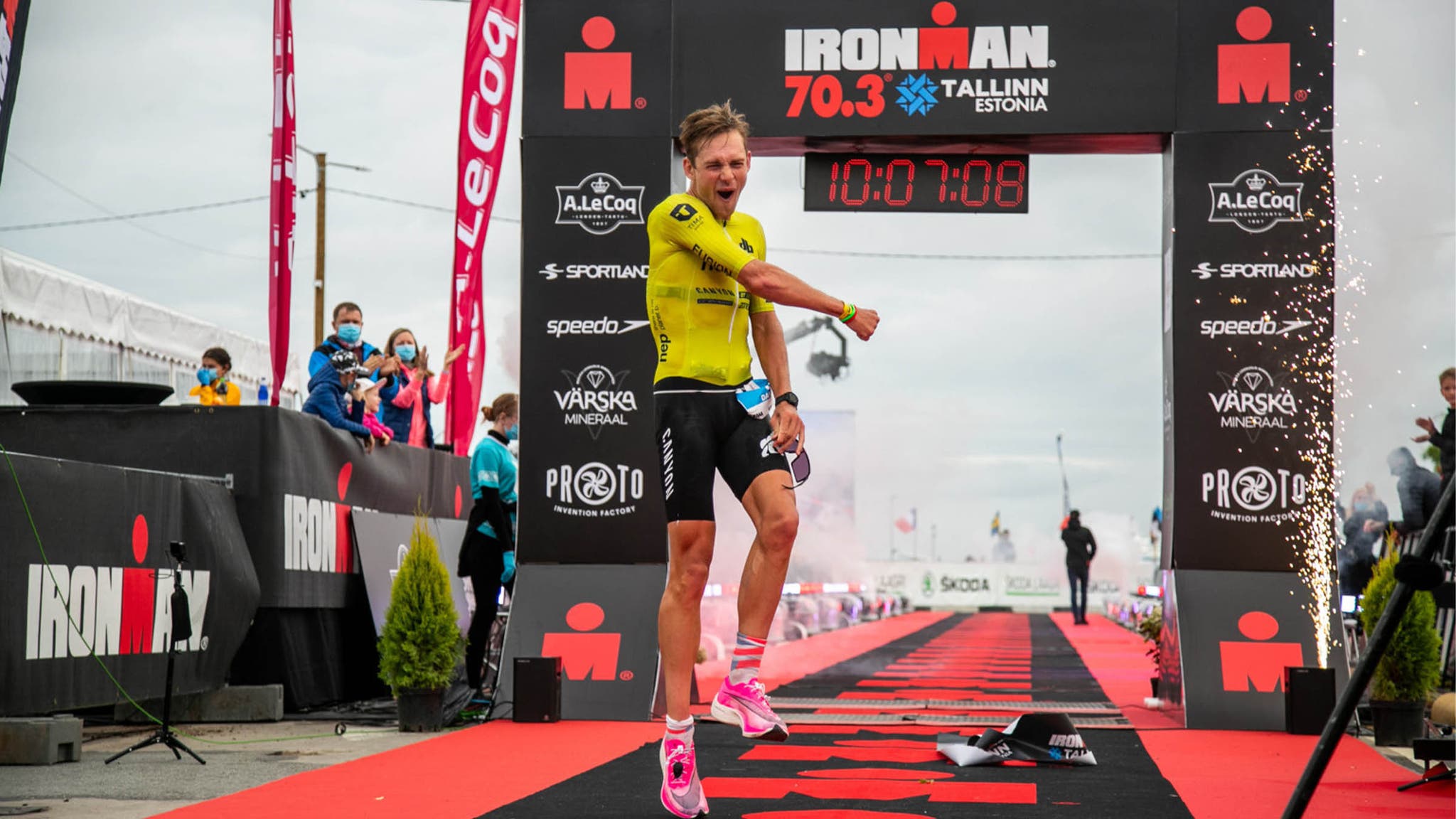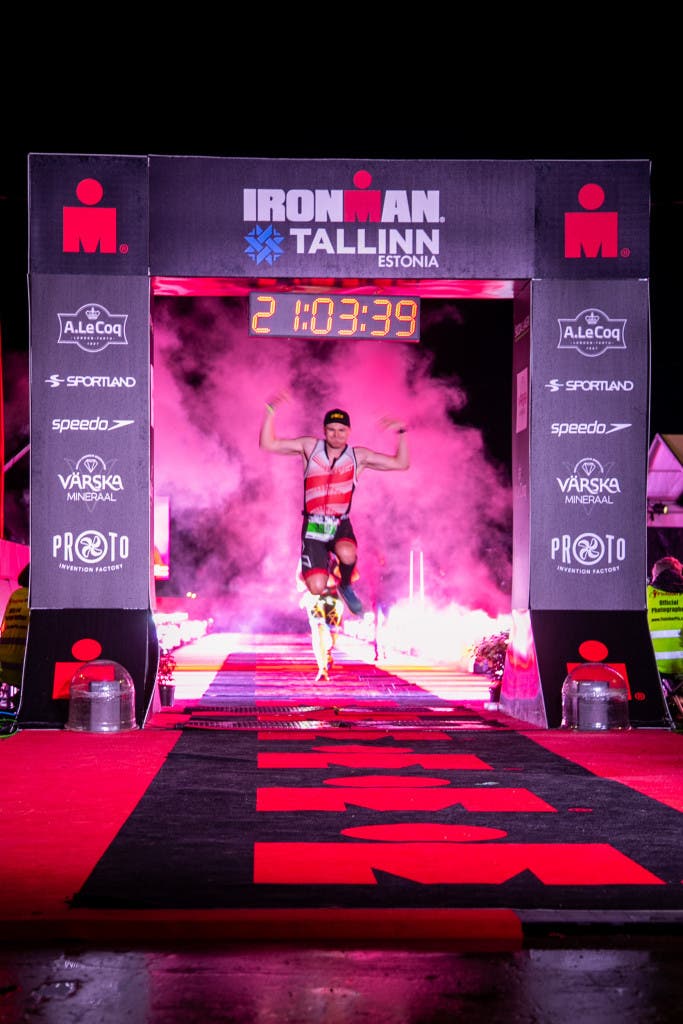At The First Ironman Since The COVID Pandemic Started

The swim start at IM Tallinn (Photo: Courtesy of IM Tallinn)
Anything is possible after all. Ironman is back.
After the slew of cancellation emails dropping faster than Ironman’s revenues, triathlon’s behemoth has finally got a full real race going again—no avatars invited.
This weekend, 1,500 athletes competed in the Ironman and 70.3 distances in Tallinn, Estonia. Strictly speaking, it’s not the only Ironman that happened. We’ve also got the Euro options of Gdynia in Poland and Les Sables d’Olonne-Vendée in France. But Tallinn is proud to be the first and only option for the full distance since the start of the COVID pandemic.
And it just had to be Tallinn. After all, this northern European enclave, with its hilltop medieval fortresses and escape from the old Soviet bloc, is as resilient as it gets. And that includes its race director.
The indomitable Ain-Alar Juhanson survived one of the world’s worst ferry disasters as a teenager. He has beaten the excoriating winds of the Canary Islands to win Ironman Lanzarote. Twice. If that’s not enough, just a few days before last year’s race, the water temperature in Estonia’s nook of the Baltic Sea plummeted to, well, Baltic temperatures, but rather than cancel the swim, they moved it—split transition to boot—five miles inland to Lake Harku. No stress. No problem.
So, cancel for a pandemic? No chance. If you want to host the first Ironman since New Zealand in March, when the world was a different place, then you need Ain at the reins.
“It’s not a job, there are much easier ways to earn money,” the 43-year-old race director said, while watching the first 70.3 athletes power away on the super-flat, blisteringly-fast 56-mile single loop bike course.
“But it’s also incredibly inspiring to work all year on something really big with a great team, and to see these guys smiling and having the race of a lifetime.” Ain-Alar was getting emotional. His relief that we were finally underway was palpable.
Registration numbers were down. Understandably. “Everyone is here who wants to be,” is how Ain-Alar puts it. Gas and mobile phones top Estonia’s imports and there’s no desire for coronavirus to join that list, so a 14-day quarantine has been slapped on the high-risk nations—those countries with infection rates above 16 per 100,000.
Some were so keen to race—including Dennis from the Netherlands—they arrived a fortnight early. “I booked for Hamburg in June. It was canceled,” he said. “They said they’d get this on. I think it’s the most special race ever! The first one since COVID—and my last one too!” After ticking enough M-Dot boxes, Dennis has decided that the “pain everywhere” is too much.
Not everyone can afford a two-week taper in Tallinn though (and with the UK on the high-risk list, an influx of British athletes—and this reporter—found themselves in a bind), so Ain-Alar and the crew pulled through again, cementing their resourceful reputation by joining forces with the World Rally Championship taking place in the south of Estonia to mount a charm offensive on the authorities.
In a hastily-arranged workaround, foreign nationals arriving from high-risk countries were able to avoided extended quarantines provided they have COVID tests both at home and upon arrival at the Tallinn airport, then stay in their hotel rooms until given the all-clear (which arrives via text within 12 hours).
The first athlete I meet is in Departures at the airport. “How’s the prep been?” I ask. “Awful” comes the reply, the grimace disguised by the disposable face mask. I nod. I’m not sure whether he means the training or the irritation caused by nostril-piercing COVID test swabs. Either way, he’s suitably negative—which, let’s be honest, is what we’re all praying for here. “Doing the full?” “Just hoping to get around.” Standard. 2020 is basically an Ironman run. Just keep shuffling through it.
It’s a pro race for the 70.3 only. Originally it was going to be an all-amateur showdown before Ain-Alar leapt to the rescue again, persuading Ironman to put up a prize purse. “We’re trying so hard to put the race on,” he said. “We do it for age-groupers, so what about the pros? They are part of our community. You see their faces, they are so happy to actually have the race.”
According to the Professional Triathletes Organization, there could even have been more than the $25,000 at stake, but Ironman officials turned down the PTO’s offer of extra cash because outside funding breaches company policy.
The race still drew a bumper European field though, headlined by Germans Sebastian Kienle and Andy Dreitz on the men’s side—a pair who could lay down enough watts to power the old city here. Kaidi Kivioja, the home nation’s sole triathlete at the 2016 Rio Olympics, and Britain’s Kat Matthews, an army physiotherapist and latest recruit of the esteemed BMC-Vifit Pro Tri Team, led the women’s charge.

Ultimately, Kienle chased Daniel Baekkegard to no avail for 3 hours 40 minutes and then tipped the young Dane as the next non-German winner of Hawaii. Both biked sub-2 hours, but the 24-year-old Danish athlete led from start to finish.
Baekkegard took Kienle’s tip as a future Kona winner in stride. “I think so too! It’s what I’m gunning for, but I have to go do it, and that’s another story. It’s a huge compliment that he even knows my name. I started triathlon because of Sebi. I watched him in Las Vegas when he did an insane attack on the bike and was flying away. I thought: ‘I have to try that.’ For a guy like him to recognize my talent and hard-work is huge,” he said.
Having broken his collarbone just two months previous and seen his comeback in Davos aborted last weekend when a lightning storm forced a cancellation mid-race, Kienle was happy to take the runner-up spot. “I called him the next non-German Hawaii champ and he’s proving I might be on the right track,” he said. “I’ve had a chat with Jan and don’t think he’s going to retire in 2021, so the chances are pretty good that they’ll be one or two more German champs. Of course, I’d love to add another title myself, but the sport is developing and if you’re a certain age it’s difficult to develop faster than the young athletes.”
In the women’s race, Matthews, who only took up tri in 2015, was out of sight early on. The UK triathlete’s potential was spotted by the BMC-Vifit Pro Tri team, whose impressive roster she’s joined for 2020, and it appears it was a wise signing.
“It was everything I expected,” Matthews said. “The atmosphere, the competitors. It was a pretty tough swim. I think the recent weather has been a bit turbulent here and there were some cheeky winds on the bike, but I just focused on speed, speed, speed.” Having been one of a handful of women to break 9 hours on Ironman debut (in Western Australia back in December), Matthews wants to turn her attention to another full distance assault in Europe next. But, of course, COVID may play a hand in that too—no one knows for sure what will happen next.
Yet, everyone was desperate to race. Hell, I was desperate just to watch. Perhaps it takes a pandemic to finally turn Ironman into a spectator sport. But then, such is the dearth of live competition these past few months, I’d be transfixed watching ladybirds arm wrestle at this point.
Once I was COVID cleared—again—I made it to the pre-race expo to see how Ironman’s Safe Return to Racing restrictions are playing out. The overarching ethos is to introduce social distancing, so that touchpoints and interaction are reduced by 90%. “The race has to be organized a completely different way,” Ain-Alar said. “Ironman implemented rolling starts a long time ago, but now we schedule everybody for everything, from registration to bike check-in to race morning.”
This sounds like the recipe for a long queue, but it actually flowed smoothly; the caveat being we’re triathlete-lite—around half of the original 3,200 sign-ups have transferred to 2021. Yet from an outsider’s view, other than the surgical masks, occasional temperature checks, and doses of hand sanitizer (triathletes are neurotic for germs pre-race anyway), it rekindles fond memories of the nervous preambles of bygones IMs. Remember those days?
It’s not all perfect. Arriving at Lake Harku for the swim start, the socially distanced set-up works perfectly—but only once triathletes step into the 50-yard funnel. Before that point it’s body-to-body neoprene as they fidget in groups of hundreds at the entrance.
The big roads on the bike course were closed, “which shows the organization has done a really good job,” Kienle said. “You feel welcomed, especially under these conditions. To set up a race like this is probably not going to bring a big profit.”
The run then left the harbor and skirted the walls of the old town—a UNESCO world heritage site‚ before sending the athletes up to its 14th Century town hall square. Described as ‘rolling,’ it climbs past the medieval Museum of Torture and by the fourth lap, Jamil, a doctor from Doha, Qatar, felt he might as well be testing the exhibits.
“It destroyed me,” he said. “I’m not used to running up and down. The views and the people are nice, but we don’t have hills in Doha. I didn’t check the elevation of the run. A small problem. But I did it!”
A downpour dampened some of the mid-afternoon M-Dot spirit, and as the sun dropped and the clock ticked toward 14 hours, there were fewer than 100 of the 693 soon-to-be finishers still out on the course. It was beginning to become a lonely plod.
Mike was on the home stretch. Just a few more turns before a well-earned PR, he yelled and crossed the line in celebratory mood—but then another vagary of the COVID regulations struck. Mike was too sore to bend to remove his timing chip, and race officials are forbidden to come to his aid. The stand-off/stand-up was eventually broken when Mike huffed off to baggage collection facing a possible timing chip infringement fee to add to the €86 COVID test—coronavirus giving athletes one last kick in the cajones.
There were the usual and much-missed fireworks and wedding proposals at the finish chute at the Noblessner port. And, while spectators are diminished, there won’t be many years when an Ironman crowd will outnumber those watching Serena Williams in action in the U.S. Open.

It was never going to all run smoothly. One athlete did test positive on arrival, but was stopped before reaching the race venue. Yet as Ironman strikes out on its COVID comeback, Estonia has proved a worthy trailblazer. “I have to come back here with more time,” Kienle said. “It seems cool with a lot of culture, and nature right next door. But the coffee festival is also on today—and that’s where I’m off to now.”
But before the caffeine fix, one final view on finally getting a race on? “Being over 30, I know a little about politics,” he mused. “Usually people would rather say ‘No,’ as they don’t want to make any mistakes, and if something happens there’ll be a lot of finger-pointing. So, I’m really happy that there are organizers like Ain out there willing to take a risk—and that we’ve finally found out that it is OK to have an Ironman race again.”